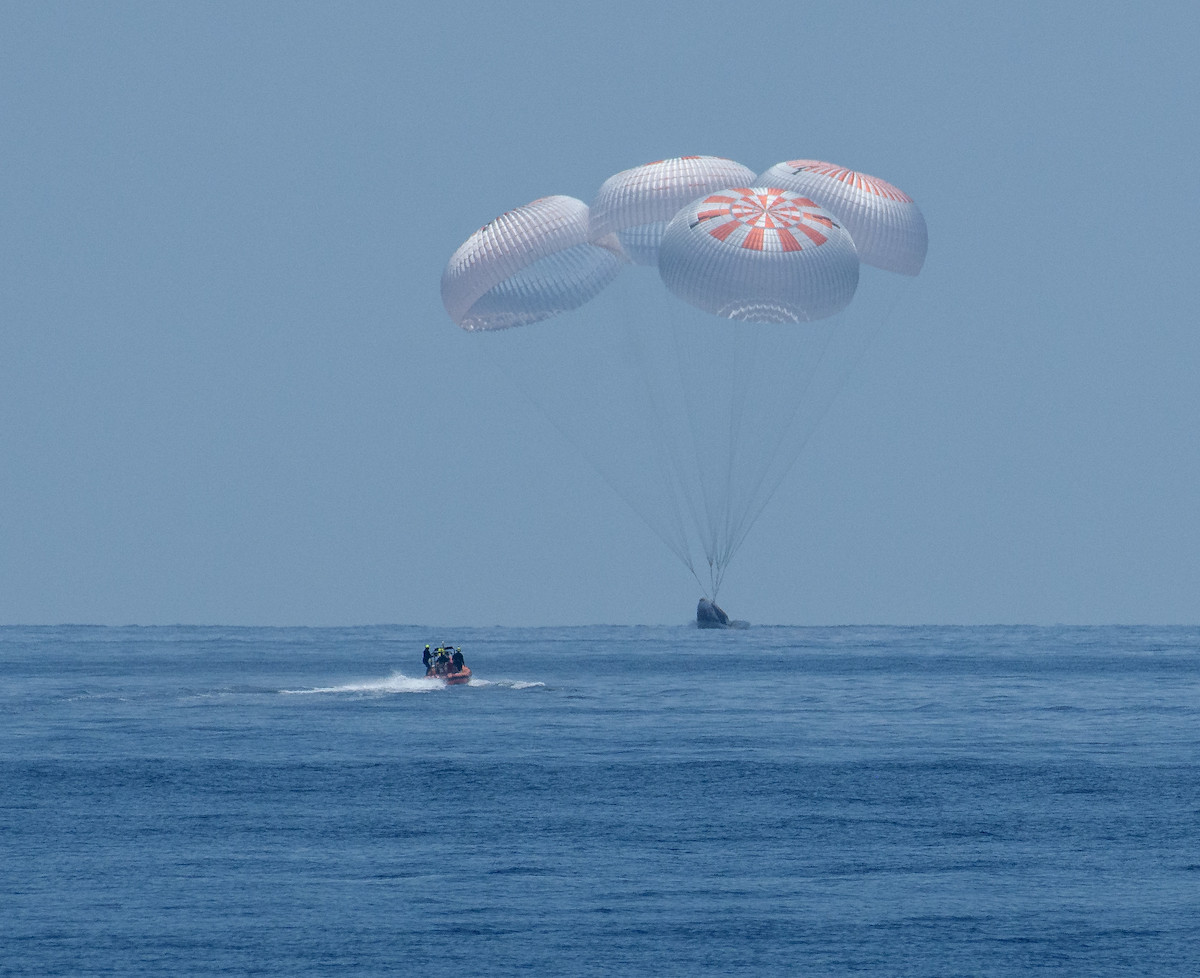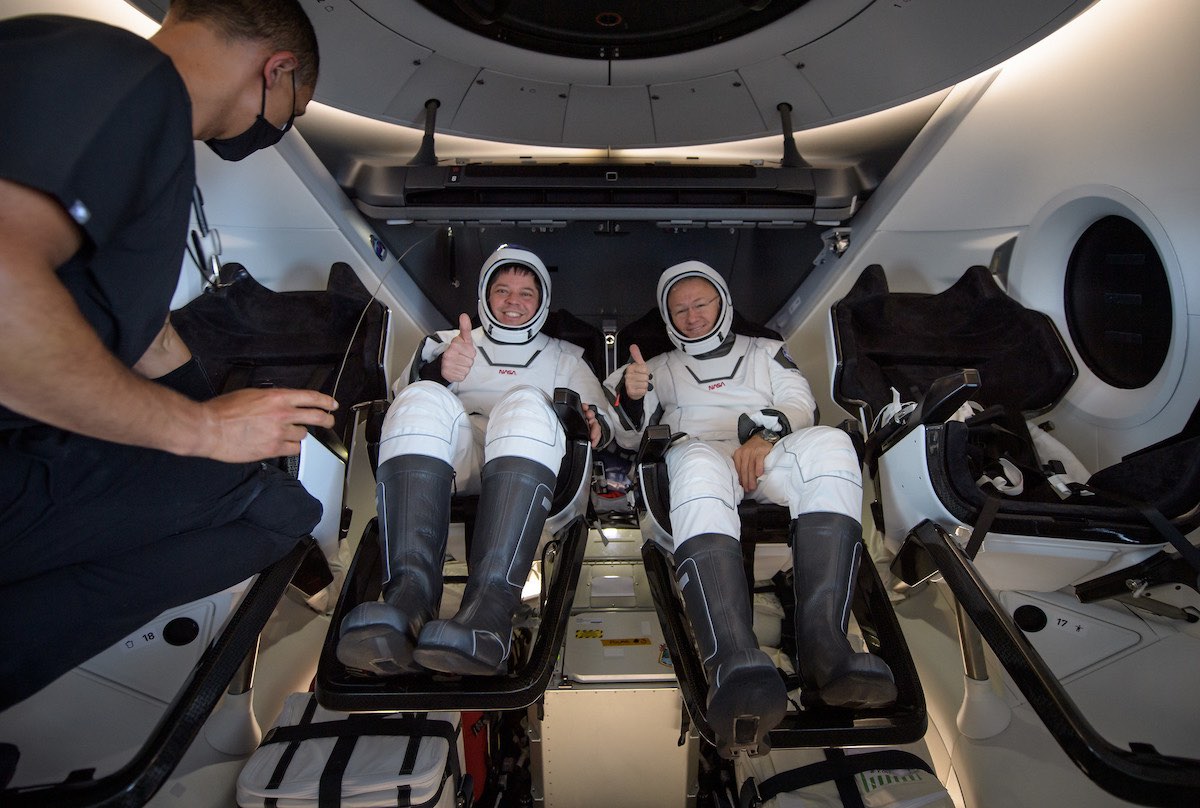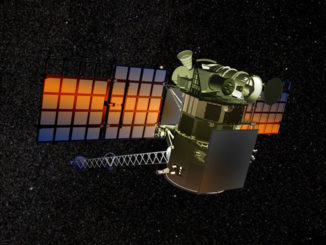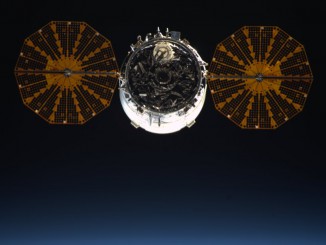
Returning home after a 64-day test flight, astronauts Doug Hurley and Bob Behnken blazed through Earth’s atmosphere and parachuted into the Gulf of Mexico inside a SpaceX Crew Dragon spacecraft Sunday, a final major step before NASA formally certifies the crew capsule for operational missions to the International Space Station.
The successful homecoming for Hurley and Behnken signaled a turning point in NASA’s commercial crew program, which fostered public-private partnerships with U.S. companies to design, develop and fly new human-rated space taxis after the retirement of the space shuttle.
The astronauts launched inside SpaceX’s Crew Dragon spaceship May 30, when they rode a Falcon 9 rocket into orbit from the Kennedy Space Center. The launch was the first time a crew rocketed into orbit from U.S. soil since the last space shuttle flight in 2011.
With Sunday’s splashdown in the Gulf of Mexico, NASA is on the verge of certifying the Crew Dragon spacecraft for regular trips to and from the space station. That will allow the space agency to end its reliance on Russia for crew transportation.
“This has been quite an odyssey the last, five, seven, eight years — five years since Bob and I started working on this program,” Hurley said after Sunday’s return. “And to be where we are now, (with) the first crewed flight of Dragon, is just unbelievable.”
Not only was Sunday’s splashdown a major milestone for NASA, it also made history in the realm of commercial spaceflight. The Crew Dragon became the first privately-owned spacecraft to carry a crew into orbit and return them safely to Earth.
“I do think what this heralds really is fundamentally a new era in spaceflight, a new era in space exploration,” said Elon Musk, SpaceX’s founder and CEO, in remarks Sunday evening in Houston to welcome home Hurley and Behnken. “We’re going to go to the moon. We’re going to have a base on the moon. We’re going to send people to Mars, and make life multi-planetary.”
After detaching from the International Space Station on Saturday night, the Dragon spacecraft carrying Hurley and Behnken lined up for a southwest-to-northeast approach to a splashdown zone in the Gulf around 34 miles (54 kilometers) off the Florida coast near Pensacola.
The capsule jettisoned its unpressurized trunk section — with the ship’s solar panels and thermal control radiator — just before firing a set of Draco rocket jets at 1:56 p.m. EDT (1756 GMT) for a deorbit burn lasting more than 11 minutes.
The braking burn changed the capsule’s velocity enough to allow Earth’s gravity to pull the spacecraft back into the atmosphere, which did the rest of the work to slow Dragon’s speed from 17,500 mph (28,000 kilometers per hour) to just 15 mph (24 kilometers per hour) for splashdown.
The spacecraft closed its nose cone a few minutes later, then encountered the uppermost fringes of the discernible atmosphere at 2:36 p.m. EDT (1836 GMT).
Wearing their white SpaceX-made flame-resistant pressure suits, the astronauts experienced up to 4Gs during entry. The capsule flew on autopilot, pointing its blunt end into the airflow as temperatures outside the spacecraft rose up to 3,500 degrees Fahrenheit (over 1,900 degrees Celsius).
A plasma sheath enshrouded the capsule for several minutes, causing an expected communication blackout between the Crew Dragon — which Hurley and Behnken named “Endeavour” — and SpaceX mission control in Hawthorne, California.
Ground teams restored the voice link with the Dragon astronauts, and a pair of drogue parachutes unfurled to stabilize the capsule. Four orange and white main parachutes deployed at an altitude of about 18,000 feet (5,500 meters) to slow the capsule’s descent in the last few minutes before splashdown.
The 13-foot-wide (4-meter), 16-foot-tall (5-meter) capsule splashed down at 2:48 p.m. EDT (1848 GMT).
Watch a replay of the splashdown. Continuing live coverage: https://t.co/v61q6Wi2P9 pic.twitter.com/lbxe6bbqvb
— Spaceflight Now (@SpaceflightNow) August 2, 2020
“Endeavour, on behalf of the SpaceX and NASA teams, welcome back to planet Earth,” radioed SpaceX’s spacecraft communicator Mike Heiman. “Thanks for flying SpaceX.”
“It was truly our honor and privilege to fly the (first) flight of the Crew Dragon Endeavour,” Hurley replied moments after splashdown. “Congratulations to everybody at SpaceX.”
The splashdown near Pensacola was the first time U.S. astronauts returned from a space mission with a splashdown at sea since 1975, when the Apollo-Soyuz Test Project mission came back to Earth. It was also the first splashdown of astronauts in the Gulf of Mexico.
Hurley and Behnken’s mission — known as Demo-2, or DM-2 — lasted 64 days since they blasted off from Florida’s Space Coast on May 30.
After reaching the space station May 31, the astronauts joined the Expedition 63 led by commander Chris Cassidy.
Cassidy and his two Russian crewmates — Anatoly Ivanishin and Ivan Vagner — will remain aboard the space station until October, when they will return to a landing in Kazakhstan on a Russian Soyuz spacecraft. Three fresh crew members will launch to the space station Oct. 14 on a new Soyuz spaceship.
During their two-month stay, Hurley and Behnken assisted Cassidy, Ivanishin and Vagner with space station duties, performing experiments and maintenance. Behnken joined Cassidy on four spacewalks in June and July to replace batteries on the space station’s solar power modules.

A SpaceX recovery vessel named “Go Navigator” was on station in the Gulf of Mexico to retrieve the Crew Dragon spaceship after it splashed down.
Two “fast boats” with recovery team members approached the capsule. After ensuring the spacecraft was safe, the larger recovery boat took position near the Dragon and hoisted the capsule out of the water using a lifting frame.
Once the Dragon was on the deck of Go Navigator, SpaceX technicians detected elevated levels of nitrogen tetroxide outside the spacecraft. The compound is used as an oxidizer for the spacecraft’s maneuvering thrusters, and is highly toxic.
The recovery team purged part of the spacecraft to rid it of the toxic contaminants before opening the hath and helping Hurley and Behnken out of the capsule for initial medical checks.
SpaceX said the recovery ship had around 44 people on-board, including SpaceX and NASA officials, doctors, nurses and other medical personnel. Spacecraft technicians were aboard to recover and secure the Dragon capsule.
Hurley and Behnken later rode a helicopter to Naval Air Station Pensacola, where they boarded a NASA aircraft for the flight back to their home base in Houston.
The astronauts came back to Earth with around 330 pounds (150 kilograms) of cargo, including frozen experiment specimens, personal gear, and a U.S. flag left on the space station by the final space shuttle crew in 2011.
Hurley was the pilot on the final space shuttle flight.
The flag also flew on STS-1, the first shuttle mission, in 1981. The final shuttle crew left it on the space station to be returned by the next astronauts to fly to the research lab on a U.S. spacecraft.
In the end, SpaceX won the “capture the flag” competition on the high frontier.
NASA awarded multibillion-dollar contracts to develop and fly new U.S.-built commercial crew capsules to SpaceX and Boeing in 2014, following several years of preliminary design work.
SpaceX, founded by Musk 18 years ago, launched a successful unpiloted Crew Dragon demonstration flight to the space station in March 2019, then overcame a setback during ground testing of the Crew Dragon’s launch abort system last year. After redesigning part of the abort system, and verifying new modifications to the capsule’s parachutes, SpaceX launched the first Crew Dragon mission with astronauts May 30.
At a ceremony welcoming home Dragon astronauts Doug Hurley and Bob Behnken, Elon Musk of SpaceX says: “I’m not very religious, but I prayed for this one.” https://t.co/v61q6Wi2P9 pic.twitter.com/mqZncEgzxt
— Spaceflight Now (@SpaceflightNow) August 3, 2020
Boeing’s CST-100 Starliner crew capsule launched into orbit for its first unpiloted test flight last December, but it ran into software problems that prevented the spacecraft from reaching the space station. Boeing recovered the spacecraft with a successful landing in New Mexico, but officials plan to re-fly the uncrewed demonstration mission later this year before clearing the Starliner to carry astronauts for the first time in 2021.
SpaceX has signed contracts with NASA on the Crew Dragon program valued at more than $3 billion. Boeing has a similar set of agreements with NASA worth more than $5 billion for the Starliner program.
Both companies have contributed undisclosed sums to the Crew Dragon and Starliner programs from their own corporate funds.
NASA says contracting out human spaceflight missions to low Earth orbit will reduce costs, freeing limited government funding for astronaut journeys to the moon, and eventually Mars.
With the Crew Dragon’s first round-trip space mission with astronauts in the books, SpaceX and NASA will analyze data from the Demo-2 test flight before formally certifying the commercial capsule for operational crew rotation launches.
The first such regular crew rotation flight, named Crew-1, is scheduled for launch this fall on a SpaceX Falcon 9 rocket from the Kennedy Space Center. Four astronauts are assigned to the Crew-1 flight.
“We’ll do a few things to get ready for certification in a few different areas,” said Steve Stich, manager of NASA’s commercial crew program. “One, we’ll review all the telemetry, all the data from the Dragon. We’ve done that for the whole flight to date. We’ll do that now for undocking all the way through splashdown and recovery.
“We do it jointly with SpaceX,” said Stich, a former NASA flight director. “We have our NASA team and SpaceX working together and going through all the data for each of the various systems — life support, propulsion, and so forth. So we’ll go through all that data to make sure that there’s nothing anomalous there.
Second, we’ll look at the parachutes,” Stich said. “The parachutes are a very important system on the vehicle. SpaceX was doing a great job of recovering their chutes today, so we’ll take those back and analyze those, look at it, just to see if they performed well.”
The Dragon capsule that flew Hurley and Behnken into space will fly again on the Crew-2 mission next year. Gwynne Shotwell, SpaceX’s president and chief operating officer, said Sunday the company’s new Dragon spacecraft design — which comes in crew and cargo variants — should be capable of five to 10 flights.
“One of the benefits of reuse, I would say, is the fact that we’ll take some of the vehicle apart,” Stich said. “The nose cone will come off, the heat shield comes off, we’ll start to inspect part of the spacecraft, and sometimes we can learn things from that.
“So we’ll do that inspection, and then we’ll put all that together and head into the certification review, probably toward the end of this month or early next month.”
Subsequent Crew Dragon missions to the space station will also launch with up to four passengers, and the spaceship — once certified after Demo-2’s return — will be capable of missions lasting up to 210 days.
While SpaceX’s core market for crew missions is with NASA and government astronauts, the company has its eyes set on flying commercial passengers. Earlier this year, SpaceX announced agreements with Axiom Space and Space Adventures, two companies that are arranging orbital expeditions with space tourists, paying passengers, and other would-be space fliers in the private sector.
One future Crew Dragon passenger could be Tom Cruise, who is planning to film a movie in orbit through a partnership with SpaceX, according to the entertainment website Deadline.
“This was an extraordinary mission, an extraordinary day for NASA, for SpaceX, and frankly for Americans and anyone interested in spaceflight,” Shotwell said Sunday, referring to the conclusion of the Demo-2 test flight. “This is really just the beginning. We are starting the journey of bringing people regularly to and from low Earth orbit, and on to the moon, and ultimately on to Mars.”
Email the author.
Follow Stephen Clark on Twitter: @StephenClark1.



